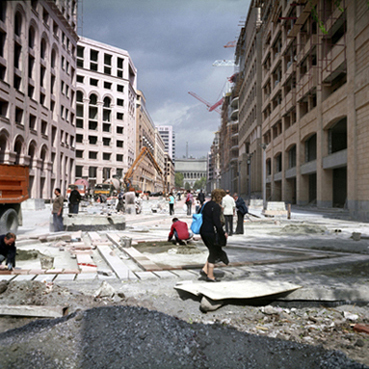Good Morning Armenia
This post is also available in:
 Anglais
Anglais
Selon la Bible, L’Arche de Noé s’échoua au sommet du mont Ararat. Le petit-fils de Noé, Hayk, donna son nom au pays: Hayastan. Ses descendants, les Arméniens, s’appellent toujours entre eux les Hays. Malgré les terribles massacres de 1915 perpétrés par le gouvernement Jeune Turque (le premier génocide du XX siècle), malgré le découpage du territoire par Staline en 1920, et malgré la guerre contre l’Azerbaïdjan de 1988 à 1994, les Arméniens, solidement attachés à leur religion, leur culture et leur langue, ont continué à sauvegarder leur identité. L’Arménie est aujourd’hui à un carrefour de son histoire, laissant derrière elle 2000 ans de domination, passant du stade de communauté religieuse et culturelle à celui de société politique et souveraine. Au cœur des enjeux majeurs qui animent le Caucase (pétrole, Iran, Azerbaïdjan), l’Arménie devient un acteur incontournable sur l’échiquier géopolitique international. Territoire, religion et société sont trois aspects fondamentaux que j’ai tenté d’aborder en me rendant dans différentes parties du pays, de la frontière turque à la frontière iranienne, en passant par la région autonome du Nagorno-Karabakh.
Good Morning Armenia
According to the Bible, Noah’s Ark was shipwrecked at the summit of Mount Ararat. Hayk, Noah’s grandson, gave its name to the country: Hayastan. His descendants, the Armenians, are still named the Hays. Despite the terrible massacres of 1915 perpetrated by the Young Turk government (the first genocide of the twentieth century), despite the division of territory by Stalin in 1920, and despite the war against Azerbaijan from 1988 to 1994, Armenians, firmly committed to their religion, their culture and language, and have continued to preserve their identity. Armenia is now at a crossroads in its history, leaving behind 2000 years of domination from the stage of a religious and cultural community to a sovereign political society. At the heart of the major issues that animate the Caucasus (oil, Iran, Azerbaijan), Armenia became a player on the international geopolitical chessboard. Territory, religion and society are three fundamental aspects that I have attempted to address in my way in different parts of the country, from the Turkish to the Iranian border, passing through the autonomous region of Nagorno-Karabakh. Good Morning Armenia
Según la Biblia, el Arca de Noé naufragó en la cumbre del monte Ararat. El nieto de Noé, Hayk, dio su nombre al país: Hayastan. Sus descendientes, los armenios, se llaman entre ellos “los Hays”.
A pesar de las terribles matanzas de 1915 perpetradas por el joven gobierno turco (el primer genocidio del siglo XX), a pesar de la división del territorio impuesta por Stalin en 1920, y a pesar de la guerra contra Azerbaiyán desde 1988 hasta 1994, los armenios, fieles a su religión, su cultura y su idioma, han sabido preservar su identidad. Armenia se encuentra hoy en una encrucijada de su historia, dejando atrás 2000 años de dominación, pasando del estado de comunidad cultural y religiosa a una sociedad política y soberana. En el centro de las grandes cuestiones que animan el Cáucaso (petróleo, Irán, Azerbaiyán), Armenia se ha convertido en un actor incontestable sobre el plano geopolítico internacional.
Territorio, religión y sociedad, son los tres aspectos fundamentales que he tratado de abordar en mi reportaje fotográfico a través de las diferentes zonas del país, desde la frontera turca hasta la frontera iraní, pasando por la región autónoma de Nagorno-Karabaj.
Good Morning Armenia
According to the Bible, Noah’s Ark was shipwrecked at the summit of Mount Ararat. Hayk, Noah’s grandson, gave its name to the country: Hayastan. His descendants, the Armenians, are still named the Hays. Despite the terrible massacres of 1915 perpetrated by the Young Turk government (the first genocide of the twentieth century), despite the division of territory by Stalin in 1920, and despite the war against Azerbaijan from 1988 to 1994, Armenians, firmly committed to their religion, their culture and language, and have continued to preserve their identity. Armenia is now at a crossroads in its history, leaving behind 2000 years of domination from the stage of a religious and cultural community to a sovereign political society. At the heart of the major issues that animate the Caucasus (oil, Iran, Azerbaijan), Armenia became a player on the international geopolitical chessboard. Territory, religion and society are three fundamental aspects that I have attempted to address in my way in different parts of the country, from the Turkish to the Iranian border, passing through the autonomous region of Nagorno-Karabakh. Good Morning Armenia
Según la Biblia, el Arca de Noé naufragó en la cumbre del monte Ararat. El nieto de Noé, Hayk, dio su nombre al país: Hayastan. Sus descendientes, los armenios, se llaman entre ellos “los Hays”.
A pesar de las terribles matanzas de 1915 perpetradas por el joven gobierno turco (el primer genocidio del siglo XX), a pesar de la división del territorio impuesta por Stalin en 1920, y a pesar de la guerra contra Azerbaiyán desde 1988 hasta 1994, los armenios, fieles a su religión, su cultura y su idioma, han sabido preservar su identidad. Armenia se encuentra hoy en una encrucijada de su historia, dejando atrás 2000 años de dominación, pasando del estado de comunidad cultural y religiosa a una sociedad política y soberana. En el centro de las grandes cuestiones que animan el Cáucaso (petróleo, Irán, Azerbaiyán), Armenia se ha convertido en un actor incontestable sobre el plano geopolítico internacional.
Territorio, religión y sociedad, son los tres aspectos fundamentales que he tratado de abordar en mi reportaje fotográfico a través de las diferentes zonas del país, desde la frontera turca hasta la frontera iraní, pasando por la región autónoma de Nagorno-Karabaj.
Photographies Nanda GONZAGUE
Du 16/11/2008 au 02/12/2008
ANTICO CASTELLO SUL MARE
Rapallo
Italie
Horaires : dal martedì alla domenica 10-12 e 16-19 lunedì chiuso - Ingresso gratuito - apertura straordinaria lunedi 1 dicembre
Téléphone : (+39) 0185.50528
info@rapallofotografiacontemporanea.it
www.rapallofotografiacontemporanea.it
Du 16/11/2008 au 02/12/2008
ANTICO CASTELLO SUL MARE
Rapallo
Italie
Horaires : dal martedì alla domenica 10-12 e 16-19 lunedì chiuso - Ingresso gratuito - apertura straordinaria lunedi 1 dicembre
Téléphone : (+39) 0185.50528
info@rapallofotografiacontemporanea.it
www.rapallofotografiacontemporanea.it
NEWSLETTER
Pour recevoir nos informations, inscrivez votre adresse email.EN SAVOIR PLUS

Pour Que l’Esprit Vive,
Association loi 1901 reconnue d’utilité publique
Siège social
20 rue Lalande,
75014 Paris – France


